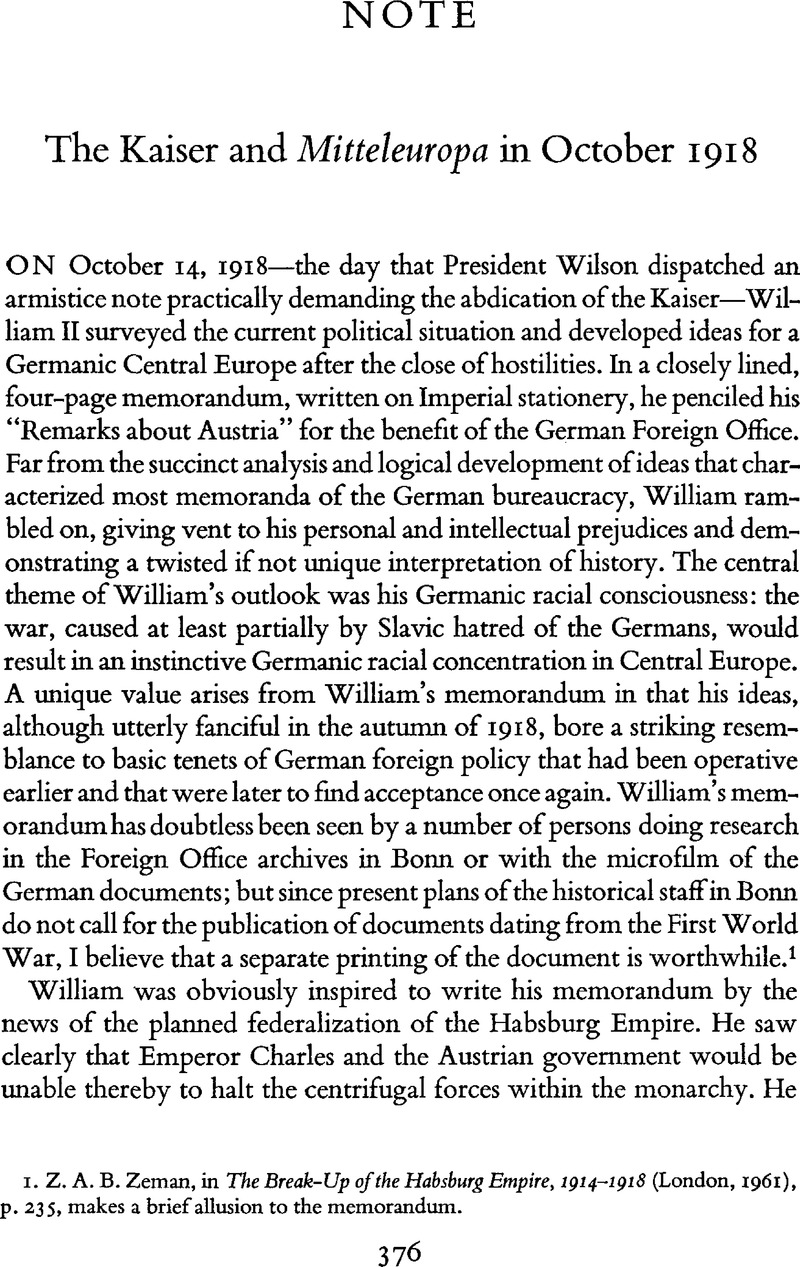No CrossRef data available.
Article contents
The Kaiser and Mitteleuropa in October 1918
Published online by Cambridge University Press: 16 December 2008
Abstract

- Type
- Note
- Information
- Copyright
- Copyright © Conference Group for Central European History of the American Historical Association 1969
References
1. Zeman, Z. A. B., in The Break-Up of the Habsburg Empire, 1914–1918 (London, 1961), p. 235,Google Scholar makes a brief allusion to the memorandum.
2. The document was dispatched on October 15 by Freiherr von Grünau, the representative of the Foreign Office to the Emperor, to Dr. Wilhelm Solf, the State Secretary for Foreign Affairs. As the initials on the covering note indicate, the document was read some days later by the leading officials of the Foreign Office, including Solf, Freiherr von dem Bussche-Haddenhausen, Freiherr Langwerth von Simmern, Carl Diego von Bergen, Rudolf Nadolny, and Prince Hatzfeld. The registers of the Foreign Office give no indication that any action was taken as a result of the memorandum.
The document became a part of the archive of the German Foreign Office. After World War II the Allied governments microfilmed it as serial number 7479, frame numbers Hr87453–61. The microfilm is in the public domain and is available from the National Archives in Washington (it is in Microcopy T-120) and the Public Record Office in London. The original document is now in the Foreign Office archive in Bonn. There, the archival number is: Abteilung IA, Oesterreich 95, vol. 7geh., Akten betreffend Beziehungen Oesterreichs zu Deutschland.
3. All italics are by William.
4. Karl Stephan was an Austrian archduke who had close ties with the Polish aristocracy. He had been mentioned repeatedly from various quarters as a possible claimant to the throne of a reconstituted Poland. As late as August 1918 the Germans had made that suggestion to the Austrians during their conference at Spa. See May, Arthur J., The Passing of the Hapsburg Monarchy (Philadelphia, 1966), pp. 155–56, 733–34.Google Scholar
5. Dr. Julius Sylvester was a leader of the German nationalist bloc in the Austrian Reichsrat. He published his account of the last days of the Monarchy, in Vom toten Parlament und seinen letzten Trägern (Vienna, 1928).Google Scholar Dr. Victor Adler, the leader of the Austrian Social Democrats but a dying man at the time, was advocating in October 1918 an Anschluss of Austria with Germany.
6. Archduke Joseph of Hungary won popularity as a military leader during the war. In June 1917 Emperor Charles considered him for the premiership of Hungary after Count Stephen Tisza's resignation. Two weeks after William wrote this memorandum, Emperor Charles appointed Archduke Joseph as palatine of Hungary. See May, Arthur J., The Passing of the Hapsburg Monarchy, pp. 91, 686, 788.Google Scholar
7. According to the account of T. G. Masaryk, a delegation from the Regency Council in Warsaw visited William at Spa at the close of September. Their purpose was to secure German assent to a plan of compensating Poland for the loss of Posnania and Galicia with areas of Lithuania, White Russia, and the Ukraine. See Masaryk, T. G., The Making of a State (London, 1927), pp. 235–36.Google Scholar




